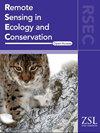Woody cover and geology as regional‐scale determinants of semi‐arid savanna stability
IF 4.3
2区 环境科学与生态学
Q1 ECOLOGY
引用次数: 0
Abstract
Savannas, defined by a balance of woody and herbaceous vegetation, are vital for global biodiversity and carbon sequestration. Yet, their stability is increasingly at risk due to climate change and human impacts. The responses of these ecosystems to extreme drought events remain poorly understood, especially in relation to the regional variations in soil, terrain, climate history and disturbance legacy. This study analysed time series of a vegetation index, derived from remote sensing data, to quantify ecosystem stability metrics, i.e., resistance and resilience, in response to a major drought event in the semi‐arid savanna of the Kruger National Park, South Africa. Using Bayesian Generalized Linear Models, we assessed the influence of ecosystem traits, past extreme climate events, fire history and herbivory on regional patterns of drought resistance and resilience. Our results show that sandier granite soils dominated by trees have higher drought resistance, supported by the ability of deep‐rooted water access. In contrast, grassier savanna landscapes on basalt soils proved more drought resilient, with rapid vegetation recovery post‐drought. The effects of woody cover on ecosystem drought response are mediated by differences in historical fire regimes, elephant presence and climate legacy, underscoring the complex, context‐dependent nature of savanna landscape response to drought. This research deepens our understanding of savanna stability by clarifying the role of regional drivers, like fire and climate, alongside long‐term factors, like soil composition and woody cover. With droughts projected to increase in frequency and severity in arid and semi‐arid savannas, it also highlights remote sensing as a robust tool for regional‐scale analysis of drought responses, offering a valuable complement to field‐based experiments that can guide effective management and adaptive strategies.半干旱稀树草原稳定性的区域尺度决定因素:植被覆盖和地质
稀树草原的定义是木本和草本植被的平衡,对全球生物多样性和碳封存至关重要。然而,由于气候变化和人类影响,它们的稳定性正日益受到威胁。这些生态系统对极端干旱事件的响应仍然知之甚少,特别是与土壤、地形、气候历史和干扰遗留的区域差异有关。本研究分析了来自遥感数据的植被指数的时间序列,以量化生态系统稳定性指标,即对南非克鲁格国家公园半干旱稀树草原重大干旱事件的抵抗力和恢复力。利用贝叶斯广义线性模型,评估了生态系统特征、过去极端气候事件、火灾历史和草食对区域抗旱性和抗旱性格局的影响。我们的研究结果表明,树木为主的砂质花岗岩土壤具有更高的抗旱性,这得益于深层根系的取水能力。相比之下,玄武岩土壤上的草甸稀树草原景观具有更强的抗旱能力,干旱后植被恢复迅速。森林覆盖对生态系统干旱响应的影响是由历史火灾制度、大象存在和气候遗产的差异介导的,这凸显了稀树草原景观对干旱响应的复杂性和环境依赖性。这项研究通过阐明区域驱动因素(如火灾和气候)以及长期因素(如土壤成分和树木覆盖)的作用,加深了我们对稀树草原稳定性的理解。鉴于干旱和半干旱稀树草原干旱的频率和严重程度预计将增加,该报告还强调了遥感作为区域尺度干旱响应分析的有力工具,为基于现场的实验提供了宝贵的补充,可以指导有效的管理和适应战略。
本文章由计算机程序翻译,如有差异,请以英文原文为准。
求助全文
约1分钟内获得全文
求助全文
来源期刊

Remote Sensing in Ecology and Conservation
Earth and Planetary Sciences-Computers in Earth Sciences
CiteScore
9.80
自引率
5.50%
发文量
69
审稿时长
18 weeks
期刊介绍:
emote Sensing in Ecology and Conservation provides a forum for rapid, peer-reviewed publication of novel, multidisciplinary research at the interface between remote sensing science and ecology and conservation. The journal prioritizes findings that advance the scientific basis of ecology and conservation, promoting the development of remote-sensing based methods relevant to the management of land use and biological systems at all levels, from populations and species to ecosystems and biomes. The journal defines remote sensing in its broadest sense, including data acquisition by hand-held and fixed ground-based sensors, such as camera traps and acoustic recorders, and sensors on airplanes and satellites. The intended journal’s audience includes ecologists, conservation scientists, policy makers, managers of terrestrial and aquatic systems, remote sensing scientists, and students.
Remote Sensing in Ecology and Conservation is a fully open access journal from Wiley and the Zoological Society of London. Remote sensing has enormous potential as to provide information on the state of, and pressures on, biological diversity and ecosystem services, at multiple spatial and temporal scales. This new publication provides a forum for multidisciplinary research in remote sensing science, ecological research and conservation science.
 求助内容:
求助内容: 应助结果提醒方式:
应助结果提醒方式:


